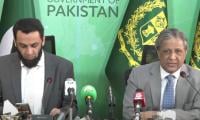KARACHI: Annual consumer price inflation shot up four-year high to seven percent in October after the government increased prices of fuels, electricity and gas, paving the way for further monetary tightening.
Pakistan Bureau of Statistics (PBS) data on Friday showed that consumer price inflation clocked in at 5.1 percent year-on-year in September and 3.8 percent in October 2017. On month-on-month basis, CPI inflation increased 2.6 percent in October compared to a decrease of 0.1 percent in the previous month and increase of 0.7 percent in October last year.
Mohammad Sohail, chief executive officer at Topline Securities said the largest contributors to October inflation were non-perishable food items, housing, water, electricity, gas, fuels and transport sectors, which contributed 1.61, 2.66 and 1.08 percentage points, respectively. Economists selected by the government to overcome its economic woes are demanding patience in pass-through of international price hikes to consumers as gas and domestic oil prices were sharply increased.
“It (inflation) is a logical outcome of rupee depreciation and increases in prices of petroleum products,” economist Ashfaque Hasan Khan, a member of the Economic Advisory Council, formed by the government, said.
“My personal view is prices of petroleum (and energy) products should not abruptly be passes on (to the consumers). The government should not use oil as a tool for tax collection.”
Annual consumer price inflation was recorded at 5.8 percent in October 2014 after having eased from 7.7 percent in the previous month.
Zeeshan Afzal, executive director of Research at Insight Securities said the inflation is cost-push and “will phase out with the passage of time”.
“(There is) no need to control it if one wants to do reforms,” Afzal said. The SBP has already predicted headline inflation for FY2019 exceeding the six percent target “primarily due to lagged pass-through of the PKR depreciation and the upward trajectory of global oil prices”.
“Headline CPI inflation stayed below the annual target for the fourth consecutive fiscal year during FY18, and clocked in at its second lowest level since FY03,” the SBP said in its annual report on state of the economy.
CPI inflation in FY2018 was recorded at 3.9 percent compared to 4.2 percent in FY2017.
While monetary policy shifted gears during the last fiscal year with growing imbalances in the economy and a challenging outlook, the central bank swung into real action in the second half. It hiked its main interest rate by 275 basis points to 8.5 percent since January.
The SBP said the real GDP growth target of 6.2 percent for FY19 appears ambitious as recent policy measures and developments including monetary tightening, exchange rate depreciation and changes in import and custom duties are likely to dampen domestic demand.
“In sum, Pakistan’s economy is again at a familiar juncture, with imbalances emerging as the growth picked up, making it challenging to maintain the virtuous equilibrium of low inflation and higher growth,” it said in the report.
The real GDP growth picked up to the 13-year high rate of 5.8 percent in the last fiscal year of 2017/18, underpinned by low cost of financing, compared to 5.4 percent a year earlier.
In October, prices of gas increased 104.91 percent year-on-year, followed by kerosene oil (31.81pc), newspapers (27.82pc), motor fuel (26.41pc), transport services (17.74pc), water supply (13.62pc), motor vehicles (12.94pc), doctor clinic fee (12.8pc), personal equipment (12.38pc), education (11.54pc), construction input items (11.07pc), medical tests (10.72pc), utensils (10.58pc), cosmetics (10.48pc) and construction wage rates (10.01pc), PBS data showed.
Chinese power company had intended to acquire up to 18.336 billion ordinary shares of K-Electric, representing 66.4...
MARI also successfully drilled and tested another appraisal well in the Mari Ghazij formation located in Mari D&PL
Gold rates decreased by $30 to $2,381 per ounce in the international market
Growing number of Americans have seen their savings dwindle as rising prices squeeze budgets while interest rates stay...
IMF will closely watch the privatization of PIA by the end of June
PSX lays down the groundwork to encourage listed companies to adopt ESG reporting in line with global standards







